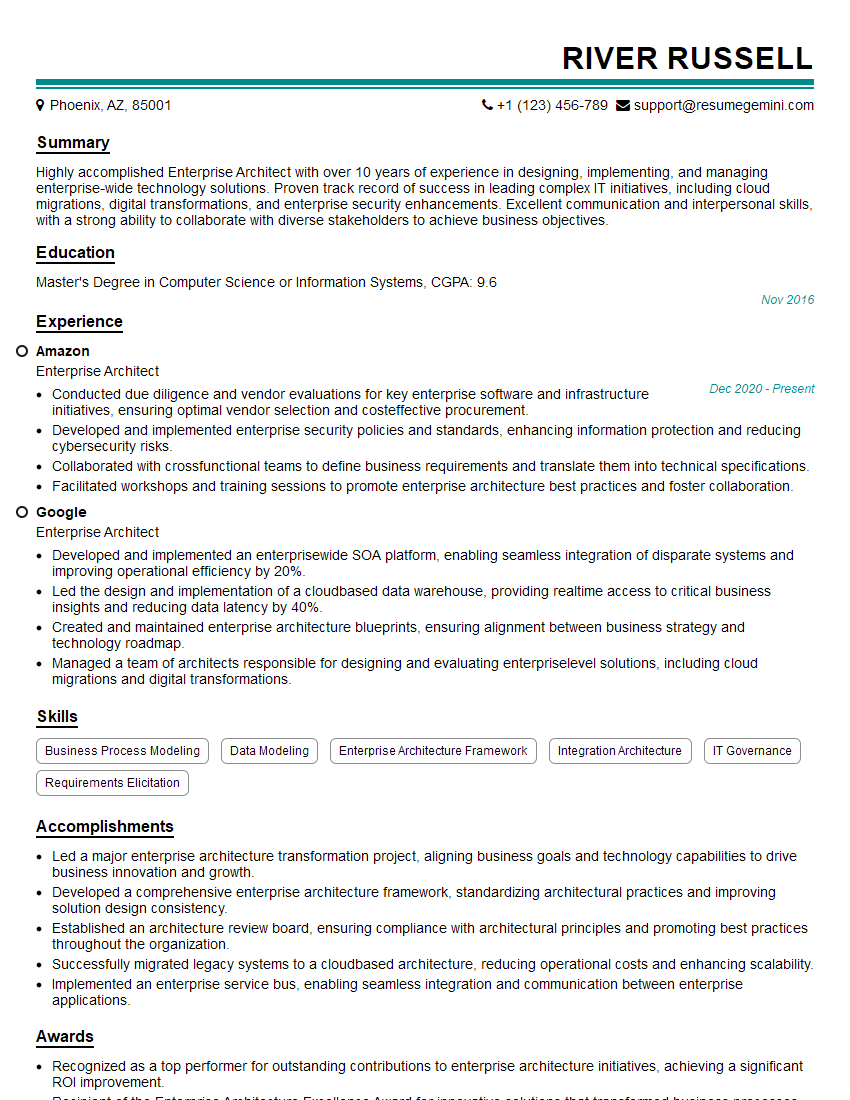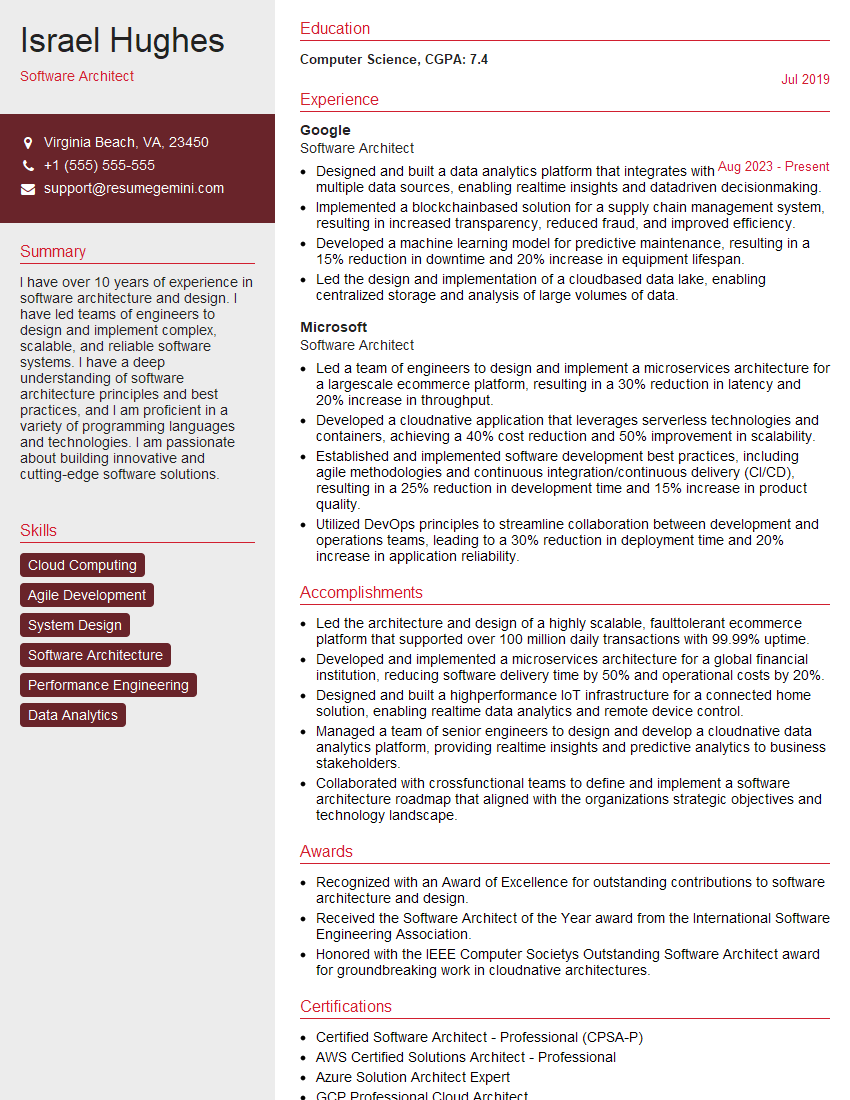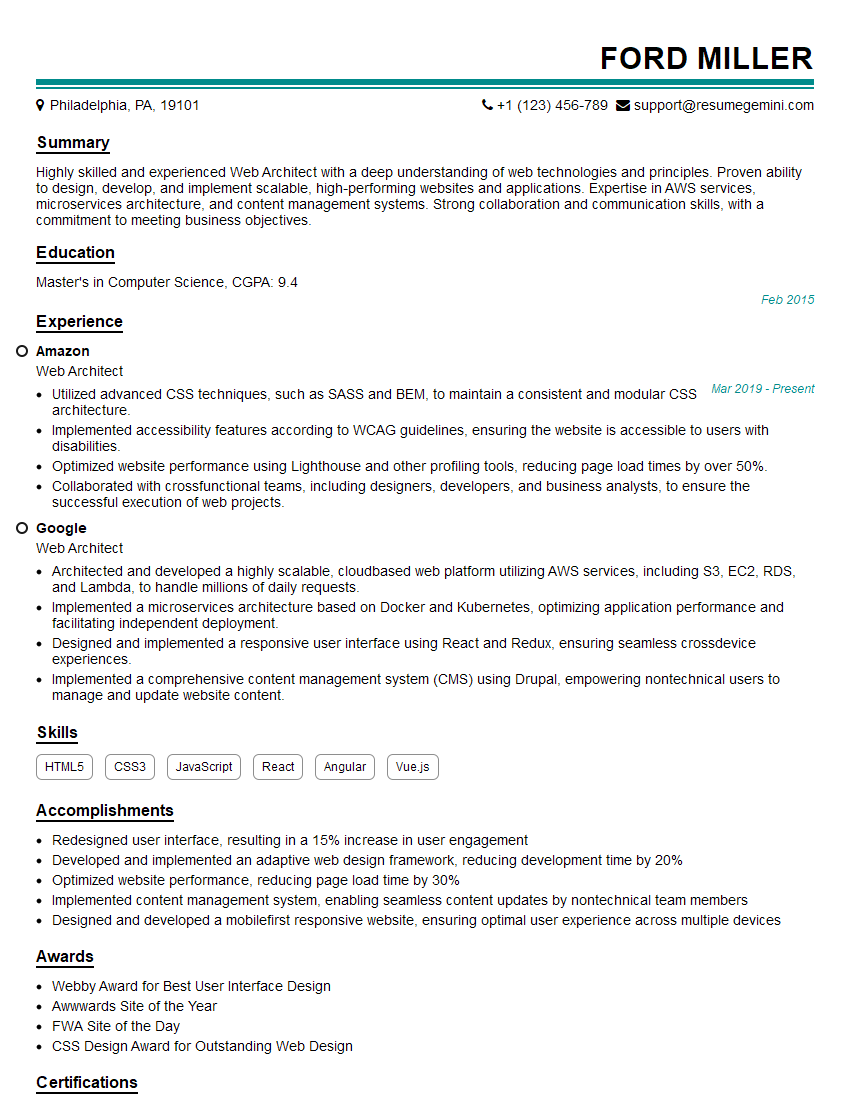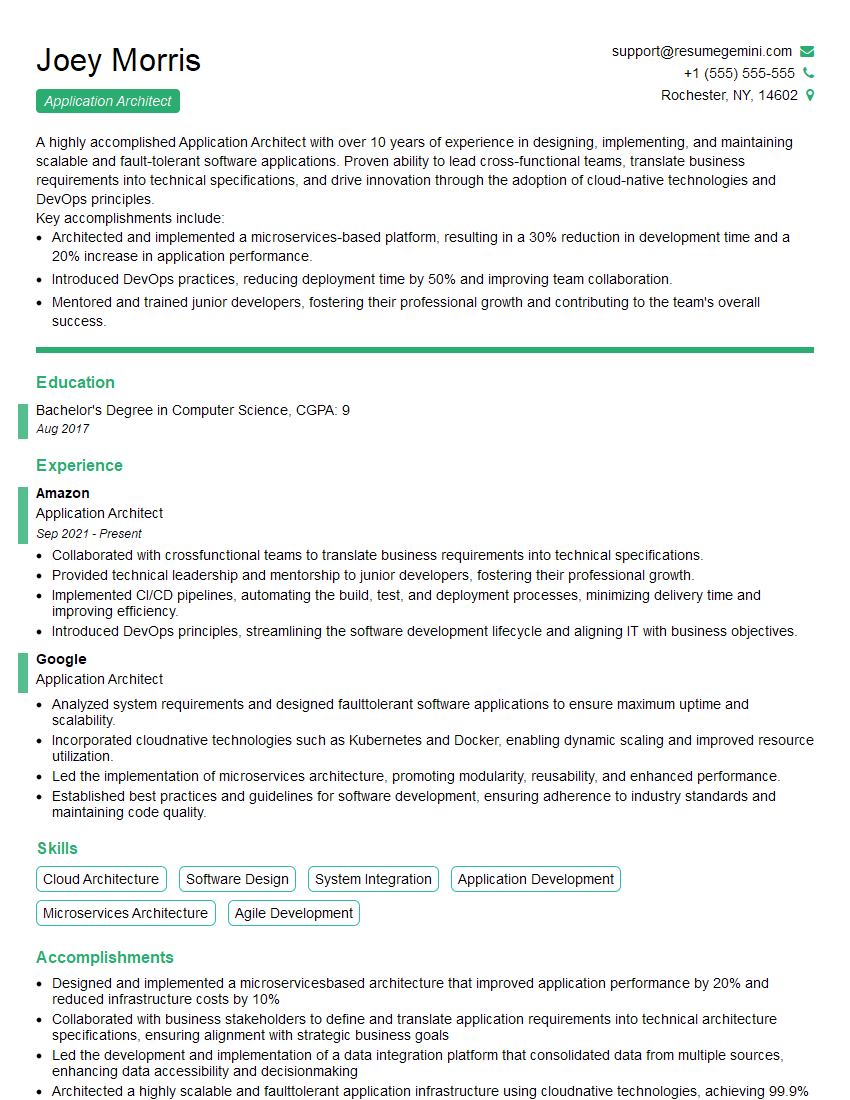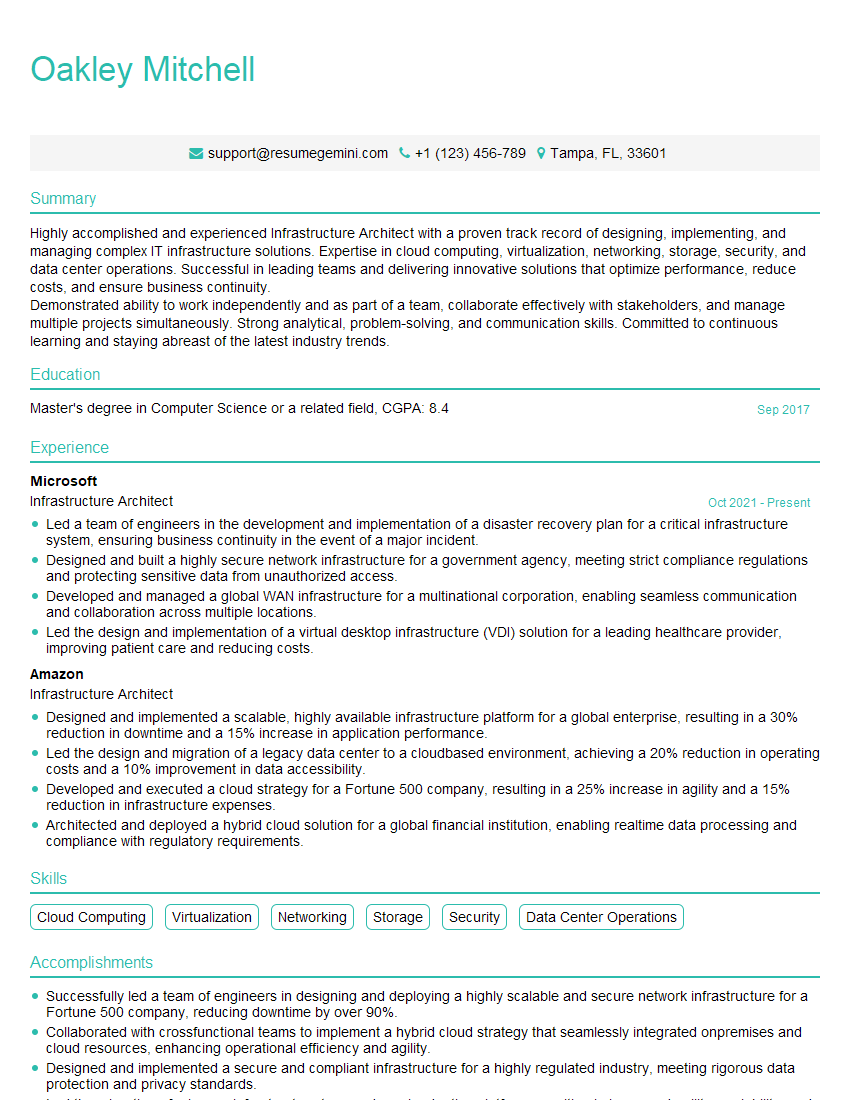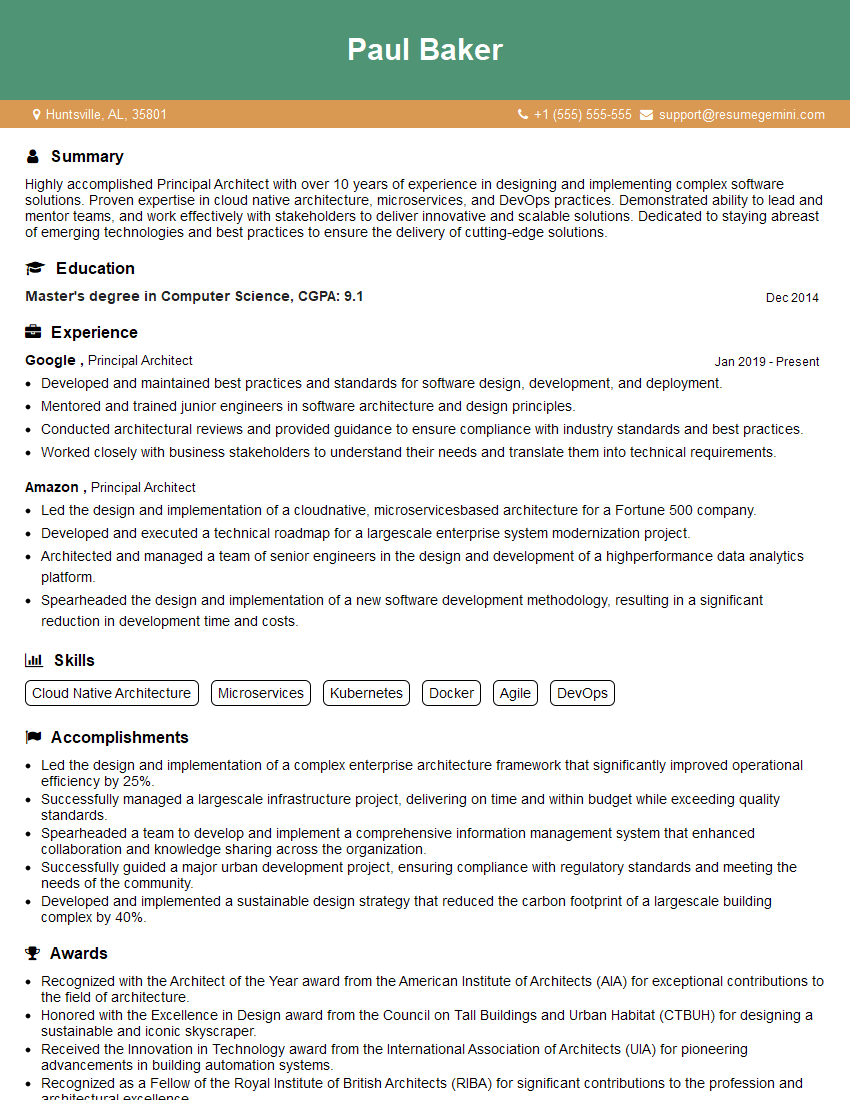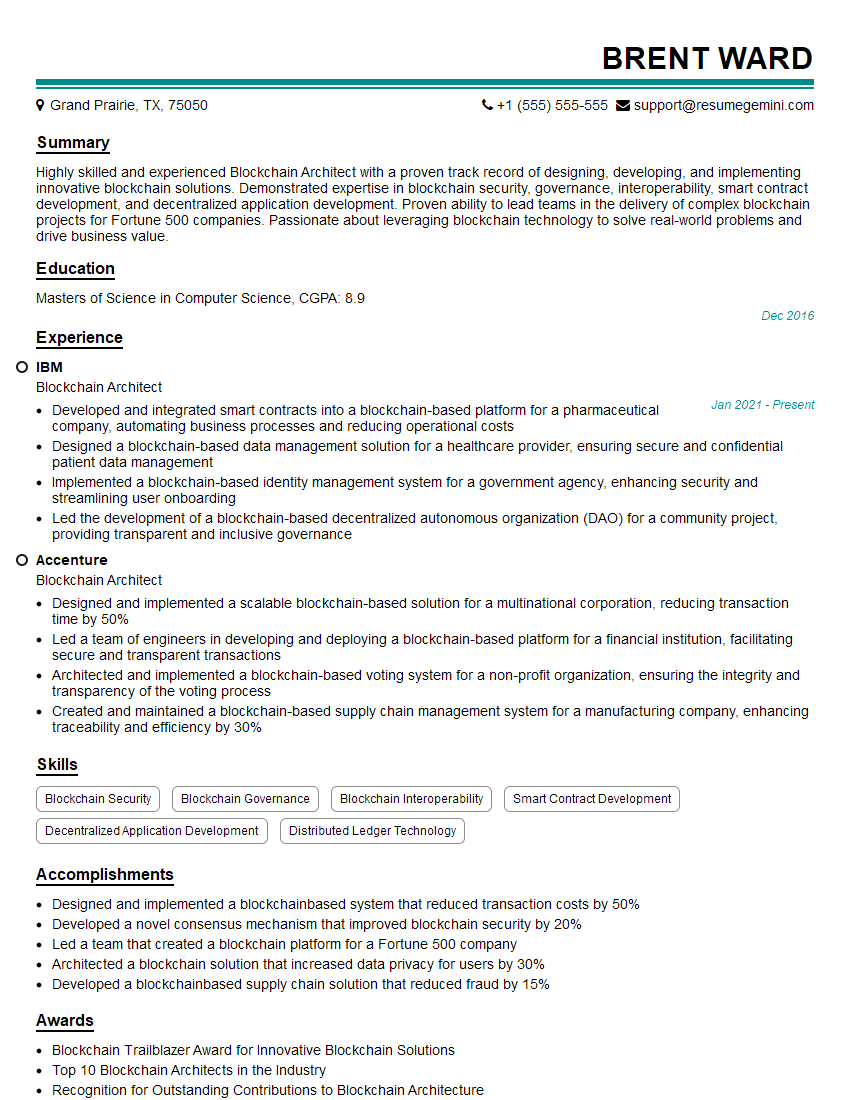Unlock your full potential by mastering the most common Architecture Evaluation interview questions. This blog offers a deep dive into the critical topics, ensuring you’re not only prepared to answer but to excel. With these insights, you’ll approach your interview with clarity and confidence.
Questions Asked in Architecture Evaluation Interview
Q 1. Explain the difference between microservices and monolithic architecture.
Monolithic and microservices architectures represent fundamentally different approaches to software design. A monolithic architecture is like a single, large apartment building: all functionalities are tightly coupled within a single unit. Changes or updates require rebuilding and redeploying the entire application. This makes it simpler to develop initially but challenging to scale and maintain as the system grows.
In contrast, a microservices architecture is more like a collection of smaller, independent apartments within a larger complex. Each microservice focuses on a specific business function and can be developed, deployed, and scaled independently. This improves flexibility, scalability, and fault isolation. However, managing the increased complexity of many interconnected services presents its own set of challenges.
Example: Imagine an e-commerce platform. A monolithic architecture would have all features (user accounts, product catalog, shopping cart, payment processing) in one codebase. A microservices architecture would break this down into separate services: a user service, a product catalog service, a shopping cart service, and a payment service, each running independently.
Q 2. Describe your experience with various architectural patterns (e.g., MVC, MVVM, layered).
I’ve worked extensively with several architectural patterns throughout my career. MVC (Model-View-Controller) is a classic pattern that separates concerns into data (Model), presentation (View), and user interaction logic (Controller). It’s simple to understand and implement but can become complex in large applications. I’ve used it successfully in many web applications.
MVVM (Model-View-ViewModel) is an evolution of MVC, often used in applications with rich user interfaces. The ViewModel acts as an intermediary between the Model and View, simplifying data binding and testing. I’ve found it particularly effective in projects leveraging frameworks like WPF or React.
Layered architecture is a common approach that organizes the system into distinct layers (presentation, business logic, data access). This promotes modularity and reusability, simplifying development and maintenance. I utilize layered architecture frequently, especially when dealing with enterprise-level applications requiring high maintainability.
The choice of pattern depends significantly on the project’s requirements and scale. For smaller projects, MVC might suffice. For complex applications, MVVM or a layered architecture may be more suitable. My experience allows me to select and effectively apply the most appropriate pattern for the task at hand.
Q 3. How do you evaluate the scalability of an existing system?
Evaluating the scalability of an existing system involves a multi-faceted approach. First, I’d analyze its current infrastructure, identifying potential bottlenecks. This often includes looking at:
- Database performance: Are there slow queries or inadequate indexing? I’d use tools like database profiling tools to pinpoint bottlenecks.
- Server capacity: Are CPU, memory, and I/O resources being maxed out under load? System monitoring tools are crucial here.
- Network bandwidth: Are network connections saturated? Network monitoring provides insights into network traffic and potential bottlenecks.
- Application design: Is the architecture designed for horizontal scaling (adding more instances)? A monolithic application will likely have scaling challenges.
Then, I’d conduct load testing, simulating realistic user traffic to identify breaking points. This helps determine the system’s capacity and expose vulnerabilities before they impact real users. Tools like JMeter or Gatling are essential for this.
Finally, I’d assess the system’s ability to handle increased data volume and user concurrency. This could involve analyzing database schema design and ensuring data partitioning strategies are effective.
Q 4. What are the key performance indicators (KPIs) you would use to assess an application’s architecture?
Key Performance Indicators (KPIs) for assessing an application’s architecture are crucial for understanding its effectiveness and identifying areas for improvement. Some essential KPIs include:
- Response time: How long does it take the system to respond to requests? A key metric for user experience.
- Throughput: How many requests can the system handle per second or minute? Indicates the system’s capacity.
- Error rate: What percentage of requests result in errors? Points to potential issues in the system’s reliability.
- Resource utilization: How efficiently are CPU, memory, and other resources being utilized? Helps identify bottlenecks.
- Scalability: How well does the system scale with increasing load? A measure of the architecture’s adaptability.
- Availability: What percentage of time is the system operational? Indicates system reliability and robustness.
The specific KPIs used would vary depending on the application’s goals and requirements. For example, a real-time trading system would prioritize low response time above all else, whereas a batch processing system might emphasize throughput.
Q 5. How do you identify architectural weaknesses or bottlenecks?
Identifying architectural weaknesses and bottlenecks requires a combination of analysis and testing. I typically follow these steps:
- Code review: Examining the codebase to identify potential performance issues, such as inefficient algorithms or poorly designed data structures.
- Performance monitoring: Using monitoring tools to track resource utilization, response times, and error rates. This helps pinpoint areas with high resource consumption or frequent failures.
- Load testing: Simulating real-world traffic to stress the system and identify its breaking points. This exposes limitations in scalability and resilience.
- Profiling: Using profiling tools to identify the most time-consuming parts of the application. This allows for targeted optimization efforts.
- Log analysis: Examining application and system logs to track errors and exceptions. This can reveal patterns indicating underlying issues.
By combining these methods, I can gain a holistic understanding of the system’s behavior and identify specific areas requiring attention. For instance, consistently high database query times may point to inefficient queries or inadequate indexing, while high CPU utilization might suggest an inefficient algorithm or lack of resources.
Q 6. Explain your approach to evaluating the security of a system’s architecture.
Evaluating the security of a system’s architecture is crucial. My approach includes a comprehensive assessment focusing on several key areas:
- Authentication and Authorization: How are users authenticated and authorized? Are strong passwords enforced? Are access control mechanisms properly implemented?
- Data protection: How is sensitive data stored, transmitted, and protected? Are appropriate encryption techniques used? Are data loss prevention measures in place?
- Input validation: How is input from users validated to prevent injection attacks (SQL injection, cross-site scripting)?
- Security testing: Penetration testing and vulnerability scanning are essential for identifying potential security flaws. This proactively identifies vulnerabilities before attackers can exploit them.
- Compliance: Does the architecture adhere to relevant security standards and regulations (e.g., GDPR, HIPAA)?
The approach is iterative, starting with a high-level review of the architecture and then delving into specific components and code. I’d utilize threat modeling techniques to identify potential threats and vulnerabilities, leading to more effective mitigation strategies.
Q 7. How do you balance performance, scalability, and security in architectural design?
Balancing performance, scalability, and security is a constant challenge in architectural design. It’s not a simple trade-off, but rather a process of finding the optimal balance for the specific context. Here’s my approach:
- Prioritization: Identify the most critical requirements. For a high-throughput system, scalability might be prioritized over absolute peak performance. For a banking system, security would be paramount.
- Architectural patterns: Choose appropriate patterns to support each requirement. Microservices can enhance scalability, while layered architecture can improve security through isolation.
- Technology selection: Use technologies well-suited for the task. A distributed caching system can improve performance, while a robust database can enhance security and data integrity.
- Optimization: Continuously monitor and optimize the system to maintain the balance. Profiling and load testing help identify areas for improvement.
- Security by design: Integrate security considerations into every stage of the development process, from architecture design to implementation and testing. This prevents security becoming an afterthought.
Ultimately, finding the right balance requires careful planning, iterative development, and continuous monitoring. It’s an ongoing process, not a one-time decision.
Q 8. Describe your experience with cloud-native architectures (e.g., AWS, Azure, GCP).
My experience with cloud-native architectures spans several years and includes extensive work with AWS, Azure, and GCP. I’ve designed and implemented numerous systems leveraging the strengths of each platform. For instance, with AWS, I’ve utilized services like EC2 for compute, S3 for storage, and Lambda for serverless functions to build highly scalable and resilient applications. On Azure, I’ve worked extensively with Kubernetes clusters managed by AKS, focusing on container orchestration and microservices architectures. In GCP, I’ve utilized their data analytics suite, including BigQuery and Dataflow, for building large-scale data processing pipelines. My approach always considers factors like cost optimization, security best practices, and disaster recovery mechanisms specific to each cloud provider.
A recent project involved migrating a monolithic application to a microservices architecture on AWS. This required careful planning to decompose the application, design inter-service communication, and implement robust monitoring and logging. We used Docker for containerization and AWS ECS for orchestration, leading to significantly improved scalability and maintainability.
Q 9. How do you handle legacy system integration into a modern architecture?
Integrating legacy systems into a modern architecture requires a strategic approach that balances the need for modernization with the constraints of existing systems. The key is to avoid a complete rip-and-replace, which is often costly and time-consuming. Instead, I typically employ a phased approach:
- Assessment: Thorough analysis of the legacy system, identifying its critical functions, data dependencies, and potential integration points.
- Abstraction: Creating an abstraction layer, such as an API gateway, to decouple the legacy system from the new architecture. This allows the modern system to interact with the legacy system without direct dependency.
- Incremental Migration: Gradually migrating functionalities from the legacy system to the modern architecture, starting with non-critical components. This reduces risk and allows for iterative improvements.
- Data Migration: Developing a robust strategy for migrating data from the legacy system to the modern database, ensuring data integrity and consistency.
- Monitoring and Testing: Implementing comprehensive monitoring and testing to ensure seamless integration and identify any performance bottlenecks or issues.
For example, I recently integrated a legacy COBOL-based billing system into a new e-commerce platform using an API gateway. This allowed the new platform to seamlessly utilize the legacy system’s billing functionality without requiring a complete rewrite of the COBOL code.
Q 10. Explain your understanding of different database architectures (e.g., relational, NoSQL).
Understanding database architectures is crucial for designing efficient and scalable systems. Relational databases (RDBMS), like MySQL or PostgreSQL, excel in managing structured data with well-defined relationships between entities. They guarantee data integrity through ACID properties (Atomicity, Consistency, Isolation, Durability). They are ideal for applications requiring complex transactions and data consistency.
NoSQL databases, conversely, are designed for handling large volumes of unstructured or semi-structured data. They offer scalability and flexibility but may compromise on data integrity. Different NoSQL types exist, including:
- Document databases (MongoDB): Store data in JSON-like documents, ideal for flexible schemas and rapidly evolving data.
- Key-value stores (Redis): Simple and fast, suitable for caching and session management.
- Graph databases (Neo4j): Efficiently manage relationships between data points, ideal for social networks or recommendation systems.
- Column-family stores (Cassandra): Optimized for high availability and scalability, often used in big data applications.
The choice depends heavily on the application’s needs. A system requiring complex transactions and strict data integrity would benefit from an RDBMS, while a system handling massive amounts of unstructured data would be better served by a NoSQL database like MongoDB or Cassandra.
Q 11. How do you approach capacity planning for a system?
Capacity planning involves predicting future resource needs to ensure a system can handle expected workloads. It’s an iterative process incorporating various techniques:
- Workload Analysis: Understanding current and projected usage patterns, including traffic volume, data storage needs, and transaction rates. This often involves analyzing historical data and extrapolating future trends.
- Resource Profiling: Determining the resource consumption (CPU, memory, disk I/O, network bandwidth) of different system components under various load conditions. Performance testing and benchmarking are essential here.
- Modeling: Using mathematical models or simulation tools to predict system behavior under different scenarios. This helps identify potential bottlenecks and optimize resource allocation.
- Scalability Strategy: Defining how the system will scale to meet future demands, whether through vertical scaling (upgrading hardware), horizontal scaling (adding more servers), or a combination of both.
- Monitoring and Adjustment: Continuously monitoring system performance and adjusting resource allocation based on actual usage patterns. This is crucial for ensuring the system remains responsive and efficient.
For example, when planning capacity for a high-traffic e-commerce website, I would analyze past peak traffic, projected growth rates, and the resource requirements of each system component. This would inform decisions about server sizing, database scaling, and caching strategies.
Q 12. Describe your experience with architectural design tools and modeling languages (e.g., UML).
I have extensive experience with architectural design tools and modeling languages, primarily UML (Unified Modeling Language). UML provides a standard way to visualize and specify system architecture, facilitating communication and collaboration among stakeholders. I frequently use diagrams like class diagrams to model data structures, sequence diagrams to illustrate interactions between components, and deployment diagrams to visualize the system’s physical layout.
Beyond UML, I’m proficient with various architectural design tools, including Lucidchart and draw.io for creating visual representations, and Enterprise Architect for more complex modeling and simulation tasks. These tools allow for collaborative design, version control, and the generation of documentation. In practice, I find that choosing the right tool depends on the project’s complexity and the team’s preferences. For simpler projects, Lucidchart might suffice, while large-scale, complex projects often necessitate more robust tools like Enterprise Architect.
Q 13. How do you ensure the maintainability of a system’s architecture?
Maintaining a system’s architecture over time requires a proactive and disciplined approach. Key strategies include:
- Modular Design: Designing the system with well-defined, independent modules that can be easily modified or replaced without affecting other parts. This promotes flexibility and reduces the risk of unintended consequences.
- Code Quality: Enforcing coding standards, conducting regular code reviews, and using automated testing to maintain high code quality and reduce technical debt.
- Documentation: Maintaining up-to-date and comprehensive documentation of the system’s architecture, design decisions, and implementation details. This is essential for onboarding new team members and facilitating future maintenance tasks.
- Refactoring: Regularly reviewing and refactoring the code to improve its structure, readability, and performance. This prevents the accumulation of technical debt and improves maintainability over the long term.
- Monitoring and Logging: Implementing robust monitoring and logging mechanisms to track system performance, identify potential issues, and provide insights into system behavior. This helps identify areas needing attention and prevents unexpected downtime.
For example, implementing a microservices architecture enhances maintainability by allowing independent deployment and scaling of individual services. Regularly scheduled code reviews and automated tests minimize bugs and improve code quality.
Q 14. Explain your process for conducting an architecture review.
My architecture review process is systematic and thorough. It involves these steps:
- Preparation: Gathering relevant documentation (architecture diagrams, design specifications, code, test results). Understanding the system’s purpose, functionality, and constraints.
- Review Session: Conducting a formal review session with relevant stakeholders (architects, developers, operations, security). The session focuses on identifying potential risks, vulnerabilities, and areas for improvement.
- Checklist-Based Assessment: Using a pre-defined checklist to ensure consistent evaluation across different systems. This covers aspects such as security, scalability, performance, maintainability, and compliance.
- Architectural Patterns and Best Practices: Assessing the adherence to established architectural patterns and best practices to identify areas for optimization and improvement.
- Risk Assessment: Identifying potential risks and vulnerabilities, assigning severity levels, and proposing mitigation strategies.
- Documentation and Follow-up: Documenting the findings, recommendations, and agreed-upon actions. Tracking the implementation of the recommended changes and monitoring their effectiveness.
I emphasize a collaborative approach, fostering open communication and encouraging constructive feedback from all participants. The goal isn’t simply to find flaws but to improve the architecture’s overall quality and resilience.
Q 15. How do you address conflicts between different architectural requirements?
Resolving conflicting architectural requirements is a core skill in architecture design. It often involves prioritizing needs, negotiating trade-offs, and finding creative solutions. Think of it like balancing a seesaw – you need to find the equilibrium point. We can’t always satisfy every requirement perfectly.
Prioritization: Employ techniques like MoSCoW analysis (Must have, Should have, Could have, Won’t have) to rank requirements based on business value and criticality. This helps focus on the most important aspects first.
Negotiation and Compromise: Facilitate discussions between stakeholders to understand the underlying needs driving each requirement. Sometimes, slight adjustments or alternative solutions can satisfy multiple requirements simultaneously. For example, if one team needs high availability and another needs low latency, exploring different caching strategies might be a compromise.
Architectural Trade-offs: Document the trade-offs explicitly. This transparency is vital. For instance, choosing a simpler, less scalable solution might reduce initial costs, but this should be clearly documented alongside potential future challenges.
Iterative Refinement: Architecture is rarely static. In an Agile environment, we revisit and refine the architecture iteratively, allowing us to address conflicts as new information emerges and priorities shift.
For example, I once worked on a project where security and performance had conflicting requirements. High security often means slower response times. We addressed this by implementing a layered security approach, applying stricter security measures only to sensitive data, allowing for faster access to less critical data.
Career Expert Tips:
- Ace those interviews! Prepare effectively by reviewing the Top 50 Most Common Interview Questions on ResumeGemini.
- Navigate your job search with confidence! Explore a wide range of Career Tips on ResumeGemini. Learn about common challenges and recommendations to overcome them.
- Craft the perfect resume! Master the Art of Resume Writing with ResumeGemini’s guide. Showcase your unique qualifications and achievements effectively.
- Don’t miss out on holiday savings! Build your dream resume with ResumeGemini’s ATS optimized templates.
Q 16. What are some common architectural anti-patterns to avoid?
Architectural anti-patterns are recurring design flaws that lead to problems down the line. Avoiding these is crucial for building robust and maintainable systems. These are like potholes in the road – they’ll slow you down and potentially cause damage.
Big Ball of Mud: This describes a system lacking any discernible architecture. It’s a chaotic jumble of code with no clear separation of concerns. This makes maintenance and evolution extremely difficult.
God Class/Object: A single class or object attempts to do too much, violating the Single Responsibility Principle. This class becomes a bottleneck and makes changes risky.
Spaghetti Code: This refers to code with highly tangled dependencies, making it hard to understand and modify. It often stems from poor design and lack of modularity.
Reinventing the Wheel: Building custom solutions for common problems when well-tested libraries or frameworks already exist. This wastes time and resources and increases maintenance overhead.
Ignoring Non-Functional Requirements: Failing to consider factors like performance, scalability, security, or maintainability during the design phase. This leads to systems that are either slow, insecure, or too difficult to manage.
To avoid these, use design principles like SOLID, follow well-established patterns, and adopt a modular design approach that promotes separation of concerns. Regular code reviews and automated testing are crucial for catching anti-patterns early on.
Q 17. How do you evaluate the cost-effectiveness of a proposed architecture?
Evaluating the cost-effectiveness of an architecture isn’t just about the initial development cost; it involves the entire lifecycle. We need to consider long-term maintainability, scalability, and operational costs.
Total Cost of Ownership (TCO): This is a crucial metric that includes initial development, deployment, ongoing maintenance, operational costs (servers, network, personnel), and potential future upgrades. This provides a comprehensive view of the financial implications.
Return on Investment (ROI): This measures the value generated by the architecture relative to its cost. We need to identify the tangible benefits, such as increased efficiency, revenue generation, or reduced operational expenses.
Cost-Benefit Analysis: This systematic approach helps weigh the costs against the benefits. It may involve creating a spreadsheet or using specialized software to model different scenarios and compare architectures.
Technology Stack Evaluation: Choosing appropriate technologies considering licensing costs, support costs, and community support is critical. Open-source options can be cost-effective in some cases, but require careful evaluation of long-term maintenance and expertise.
In one project, we compared a cloud-native approach to a traditional on-premise solution. While the cloud had higher initial setup costs, the long-term savings in infrastructure and maintenance made it more cost-effective in the long run.
Q 18. Describe your experience with Agile and DevOps methodologies in relation to architecture.
Agile and DevOps methodologies significantly impact architecture. They demand more iterative and collaborative approaches to design.
Agile: Agile principles emphasize incremental development, frequent feedback, and adaptation to changing requirements. The architecture needs to be flexible enough to accommodate these changes. This often involves using microservices or other modular approaches that allow for independent development and deployment of components.
DevOps: DevOps promotes close collaboration between development and operations teams. The architecture must support automation of deployment, testing, and monitoring processes. This typically involves Infrastructure as Code (IaC), continuous integration/continuous delivery (CI/CD) pipelines, and robust monitoring systems.
In my experience, using a microservices architecture within an Agile and DevOps framework allows for faster delivery, greater flexibility, and improved resilience. We can deploy and update individual services independently, reducing downtime and deployment risks. I’ve successfully used this approach to deliver critical features faster and adapt to changing business needs.
Q 19. How do you document architectural decisions and their rationale?
Documenting architectural decisions is crucial for maintainability and communication. It’s essentially the blueprint for your system.
Architectural Decision Records (ADR): ADMs are a well-structured way to document decisions. Each ADR should clearly state the context, decision, consequences, and rationale. This ensures that future developers and stakeholders understand the “why” behind the design choices.
Diagrams: Visual representations like UML diagrams, sequence diagrams, and component diagrams are essential for communicating complex systems. They provide a high-level overview and help stakeholders visualize the interactions between components.
Version Control: Store architecture documents in a version control system (e.g., Git) to track changes and facilitate collaboration. This approach ensures that the architecture documentation is consistently updated and easily accessible.
Wiki or Knowledge Base: A central repository for all architecture documentation, including ADMs, diagrams, and other relevant information. This makes it easy to find and share information across the team.
I typically use a combination of ADMs and diagrams stored in a Git repository alongside the code. This allows for easy access to the documentation and enables traceability between the code and the architectural decisions.
Q 20. What is your approach to risk assessment and mitigation in architecture design?
Risk assessment is an integral part of architectural design. Identifying and mitigating potential risks early on is key to building a successful system.
Identify Potential Risks: This involves considering factors such as technical feasibility, security vulnerabilities, performance bottlenecks, regulatory compliance, and dependencies on third-party services.
Risk Assessment Matrix: A matrix that categorizes risks based on likelihood and impact. This helps prioritize mitigation efforts. High-likelihood, high-impact risks should be addressed first.
Mitigation Strategies: Develop strategies to reduce the likelihood or impact of identified risks. This might involve choosing more robust technologies, implementing security measures, or designing for fault tolerance.
Contingency Planning: Define fallback plans in case risks materialize. This includes developing recovery strategies and identifying alternative solutions.
Regular Monitoring and Review: Continuously monitor the system for potential risks and adapt the architecture as needed. This is especially important in a constantly evolving environment.
For instance, in a project dealing with sensitive user data, I identified data breaches as a high-risk. We implemented robust security measures, including encryption at rest and in transit, access controls, and regular security audits to mitigate this risk.
Q 21. How do you handle technical debt in an existing architecture?
Technical debt is unavoidable in software development. The key is to manage it effectively.
Identify and Categorize: Start by identifying existing technical debt. Categorize it based on severity, impact, and the effort required to address it. This creates a prioritized list.
Prioritization: Prioritize addressing technical debt based on its impact on the system’s performance, stability, maintainability, and future development. High-impact debts should be addressed earlier.
Refactoring: Gradually refactor code to improve its design and reduce complexity. This involves making small, incremental changes that reduce technical debt without disrupting functionality.
Strategic Debt Management: Deliberately taking on technical debt for strategic reasons, for example, to quickly deliver a minimum viable product (MVP). This should be documented and a plan should be put in place for addressing this debt later.
Continuous Improvement: Implement practices like code reviews, automated testing, and static analysis to prevent the accumulation of new technical debt. These processes increase code quality and reduce the likelihood of future issues.
I’ve used a Kanban board to track and manage technical debt in several projects. This visual representation of the debt helps prioritize refactoring tasks and facilitates discussions around tackling it. We also incorporated specific time allocated for refactoring into our sprint planning.
Q 22. Describe your experience with different architectural governance models.
Architectural governance models define how architectural decisions are made, documented, and enforced within an organization. They range from highly centralized, where a central architecture team dictates all decisions, to decentralized models where individual teams have more autonomy. My experience spans several models:
- Centralized Governance: I’ve worked in environments where a dedicated Architecture Board approves all significant architectural decisions. This ensures consistency and adherence to enterprise standards, but can sometimes lead to slower decision-making. For example, in a large financial institution, all changes to core banking systems required rigorous review and approval from the Architecture Board, ensuring security and stability.
- Decentralized Governance: I’ve also supported more agile organizations using a decentralized approach. Here, individual teams own their architectural decisions, guided by overarching principles and standards documented in an architecture framework. This speeds up development but necessitates robust communication and alignment across teams. A successful example involved a tech startup where each product team had architectural autonomy, collaborating through a shared architectural repository and regular knowledge-sharing sessions.
- Federated Governance: This model combines elements of both centralized and decentralized approaches. There’s a central architecture team setting overarching guidelines, but individual domains or business units have some autonomy within those boundaries. This provides a good balance between agility and consistency. I witnessed this in a large manufacturing company where each plant had its own IT architecture, but all systems adhered to enterprise-wide security and data standards.
My experience allows me to adapt my approach to the specific needs and maturity of an organization, recognizing the trade-offs inherent in each model.
Q 23. How do you measure the success of an architectural design?
Measuring the success of an architectural design is multifaceted and requires a holistic approach. It’s not just about technical performance, but also about aligning with business objectives and ensuring long-term viability. Key metrics include:
- Performance: This encompasses aspects like system responsiveness, scalability, and reliability. We’d use monitoring tools and performance testing to track key indicators.
- Security: Robust security is paramount. Success is measured by the absence of security breaches and successful penetration testing results.
- Maintainability: A well-designed architecture is easy to maintain and evolve. This can be assessed through metrics like code complexity, technical debt, and deployment frequency.
- Cost-Effectiveness: The architecture should deliver value within budget. We’d track infrastructure costs, development effort, and operational expenses.
- Business Alignment: The architecture must support business goals and strategic objectives. This requires regular feedback from business stakeholders and demonstrating how architectural choices contribute to business outcomes. For example, a reduction in customer support calls following a system upgrade would demonstrate the success of an architectural change aimed at improving user experience.
Ultimately, success is defined by the ability of the architecture to achieve its intended purpose while meeting various quality attributes. We often employ a balanced scorecard approach to track progress across these diverse dimensions.
Q 24. Explain your understanding of architectural trade-offs.
Architectural trade-offs are inherent in any design process. It’s rarely possible to optimize all aspects of a system simultaneously. We often face choices between competing goals, such as:
- Performance vs. Cost: A highly performant system might require expensive hardware and specialized infrastructure.
- Scalability vs. Complexity: Highly scalable systems can be complex to develop and maintain.
- Security vs. Usability: Enhanced security measures might impact user experience.
- Flexibility vs. Speed of Development: A highly flexible architecture might require more upfront design effort.
Understanding these trade-offs is crucial. The process involves carefully analyzing the priorities of the stakeholders, quantifying the costs and benefits of each option, and making informed decisions that balance competing requirements. For instance, in a project with a tight deadline, we might prioritize faster development over maximum flexibility, accepting a more limited architecture in the short term, while planning for future scalability in a subsequent release.
Q 25. How do you stay up-to-date with the latest architectural trends and technologies?
Staying current in architecture requires a multi-pronged approach:
- Industry Conferences and Events: Attending conferences like QCon, Devoxx, and various vendor-specific events provides valuable insights into cutting-edge technologies and best practices.
- Online Courses and Tutorials: Platforms like Coursera, edX, and Udemy offer excellent resources for learning new technologies and architectural patterns.
- Publications and Blogs: Following industry blogs, white papers, and research publications keeps me informed about emerging trends and best practices.
- Open Source Projects: Engaging with open-source projects allows me to see real-world implementations of architectural patterns and learn from experienced developers.
- Professional Networks: Participating in online forums, communities, and attending meetups facilitates interaction with other architects and fosters knowledge exchange.
Continual learning is essential to remain relevant and effective in this rapidly evolving field.
Q 26. Describe a time you had to make a difficult architectural decision. What was the outcome?
In a previous project, we faced a difficult decision regarding the database technology for a new e-commerce platform. Initially, we favored a NoSQL solution for its scalability and flexibility. However, our data modeling requirements were complex and the team lacked extensive experience with NoSQL at the time. Choosing a relational database would have been simpler and faster in the short term but potentially limited scalability in the long run.
After extensive discussions, weighing the trade-offs, and considering the team’s capabilities, we opted for a hybrid approach. We used a relational database for transactional data and a NoSQL database for less structured, high-volume data such as user reviews. This mitigated the risks associated with solely relying on a less-familiar technology while addressing the scalability needs. The outcome was successful. The system launched on time and met performance expectations. While the hybrid approach introduced additional complexity, it proved more adaptable to the system’s evolution and offered better scalability compared to a purely relational approach.
Q 27. How do you ensure alignment between business goals and architectural decisions?
Ensuring alignment between business goals and architectural decisions requires constant communication and collaboration between architects and business stakeholders. Key strategies include:
- Early and Frequent Stakeholder Engagement: Involving business stakeholders from the outset ensures architectural decisions reflect business needs and priorities. This can involve workshops, presentations and collaborative planning sessions.
- Value-Driven Architecture: Framing architectural decisions in terms of their business value helps demonstrate their relevance and importance to the organization. For example, discussing how a specific architectural decision will improve customer satisfaction or reduce operational costs.
- Architectural Roadmaps: Developing architectural roadmaps that align with the business’s strategic objectives creates a clear vision and helps guide future decisions.
- Measurable Outcomes: Defining measurable outcomes for architectural initiatives provides a way to track progress and demonstrate success in achieving business goals. These could be related to performance, cost savings, or customer satisfaction improvements.
- Clear Communication: Architects must effectively communicate technical concepts in a way that business stakeholders can understand, using clear language and avoiding technical jargon whenever possible.
By actively involving stakeholders, focusing on business value, and communicating effectively, we ensure alignment between architecture and business goals, maximizing the impact of architectural choices on business success.
Key Topics to Learn for Architecture Evaluation Interview
- Architectural Styles and Patterns: Understanding various architectural styles (microservices, monolithic, layered, etc.) and their suitability for different projects. Practical application: Analyzing an existing system and proposing an improved architecture based on identified patterns.
- Scalability and Performance: Evaluating the scalability and performance characteristics of different architectures. Practical application: Identifying bottlenecks and proposing solutions to improve system performance under load.
- Security Considerations: Assessing security risks and vulnerabilities within different architectural designs. Practical application: Developing a security architecture blueprint to mitigate identified threats.
- Maintainability and Extensibility: Evaluating the maintainability and extensibility of an architecture. Practical application: Designing an architecture that facilitates easy updates, upgrades, and future feature additions.
- Cost and Resource Optimization: Analyzing the cost-effectiveness and resource utilization of proposed architectures. Practical application: Comparing different architectural options and justifying the choice based on cost-benefit analysis.
- Technology Stack Evaluation: Assessing the appropriateness and compatibility of technologies within a chosen architecture. Practical application: Justifying the selection of specific technologies based on project requirements and constraints.
- Data Modeling and Management: Understanding how data flows and is managed within the architecture. Practical application: Designing efficient data models and database strategies to support the application’s needs.
- Deployment Strategies and DevOps: Considering deployment models and DevOps practices during architectural evaluation. Practical application: Proposing a robust and efficient deployment pipeline for the application.
Next Steps
Mastering Architecture Evaluation is crucial for career advancement in software development and related fields. A strong understanding of architectural principles allows you to design robust, scalable, and secure systems, making you a highly valuable asset to any team. To significantly boost your job prospects, invest time in crafting an ATS-friendly resume that effectively highlights your skills and experience. ResumeGemini is a trusted resource that can help you build a professional and impactful resume tailored to your specific needs. Examples of resumes tailored to Architecture Evaluation are provided to help you get started.
Explore more articles
Users Rating of Our Blogs
Share Your Experience
We value your feedback! Please rate our content and share your thoughts (optional).
What Readers Say About Our Blog
Hi, I’m Jay, we have a few potential clients that are interested in your services, thought you might be a good fit. I’d love to talk about the details, when do you have time to talk?
Best,
Jay
Founder | CEO

